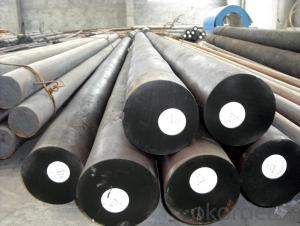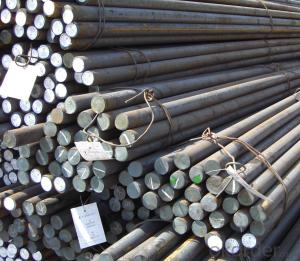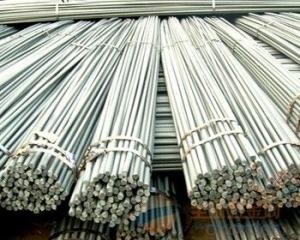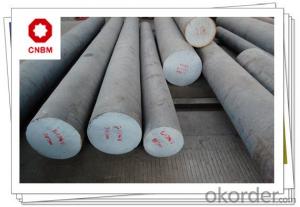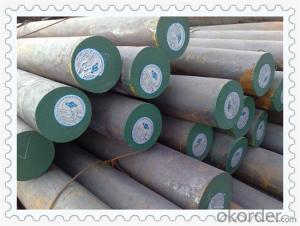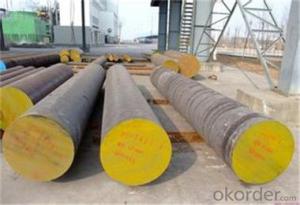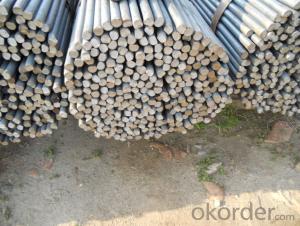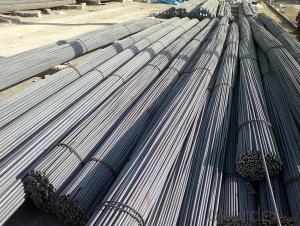Hot Rolled Prime Low Carbon Steel Round Bar
- Loading Port:
- China main port
- Payment Terms:
- TT OR LC
- Min Order Qty:
- 100 m.t.
- Supply Capability:
- 5000 m.t./month
OKorder Service Pledge
OKorder Financial Service
You Might Also Like
Product Description:
OKorder is offering Hot Rolled Prime Low Carbon Steel Round Bar at great prices with worldwide shipping. Our supplier is a world-class manufacturer of steel, with our products utilized the world over. OKorder annually supplies products to African, South American and Asian markets. We provide quotations within 24 hours of receiving an inquiry and guarantee competitive prices.
Product Applications:
Hot Rolled Prime Low Carbon Steel Round Bar are ideal for structural applications and are widely used in the construction of buildings and bridges, and the manufacturing, petrochemical, and transportation industries.
Product Advantages:
OKorder's Hot Rolled Prime Low Carbon Steel Round Bar are durable, strong, and wide variety of sizes.
Main Product Features:
· Premium quality
· Prompt delivery & seaworthy packing (30 days after receiving deposit)
· Can be recycled and reused
· Mill test certification
· Professional Service
· Competitive pricing
Product Specifications:
Manufacture: Hot rolled
Grade: Q195 – 235
Certificates: ISO, SGS, BV, CIQ
Length: 6m – 12m, as per customer request
Packaging: Export packing, nude packing, bundled
| ROUND BAR | |
| SIZE d(mm) | theoretical kg/m |
| 5.5 | 0.186 |
| 6 | 0.222 |
| 7 | 0.302 |
| 8 | 0.395 |
| 9 | 0.499 |
| 10 | 0.617 |
| 11 | 0.746 |
| 12 | 0.888 |
| 13 | 1.04 |
| 14 | 1.21 |
| 15 | 1.39 |
| 16 | 1.58 |
| 17 | 1.78 |
| 18 | 2 |
| 19 | 2.23 |
| 20 | 2.47 |
| 21 | 2.72 |
| 22 | 2.98 |
| 24 | 3.55 |
| 25 | 3.85 |
| 26 | 4.17 |
| 28 | 4.83 |
| 30 | 5.55 |
| 32 | 6.31 |
| 34 | 7.13 |
| 36 | 7.99 |
| 38 | 8.9 |
| 40 | 9.86 |
| 42 | 10.9 |
| 45 | 12.5 |
| 48 | 14.2 |
| 50 | 15.4 |
| 53 | 17.3 |
| 56 | 19.3 |
| 60 | 22.2 |
| 63 | 24.5 |
| 65 | 26 |
| 70 | 30.2 |
| 75 | 34.7 |
| 80 | 39.5 |
| 85 | 44.5 |
| 90 | 49.9 |
| 95 | 55.6 |
| 100 | 61.7 |
FAQ:
Q1: How soon can we receive the product after purchase?
A1: Within three days of placing an order, we will arrange production. The normal sizes with the normal grade can be produced within one month. The specific shipping date is dependent upon international and government factors, the delivery to international main port about 45-60days.
Q2: what is the difference between actual weight and theoretical weight?
A2: All the section steel has two weights: actual weight and theoretical weight. Actual weight is the weighing out when the product delivered from the mill. Theoretical weight is calculated by pieces. The invoice can be based on each of them as your request
Q3: How many tons of steel products could be loaded in containers?
A3: Usually the steel products are delivered by bulk vessel because of the large quantity and the freight. However, there are no bulk vessel enter some seaports so that we have to deliver the cargo by containers. The 6m steel product can be loaded in 20FT container, but the quantity is changed according to the size, usually from 18tons to 25tons.
Images:
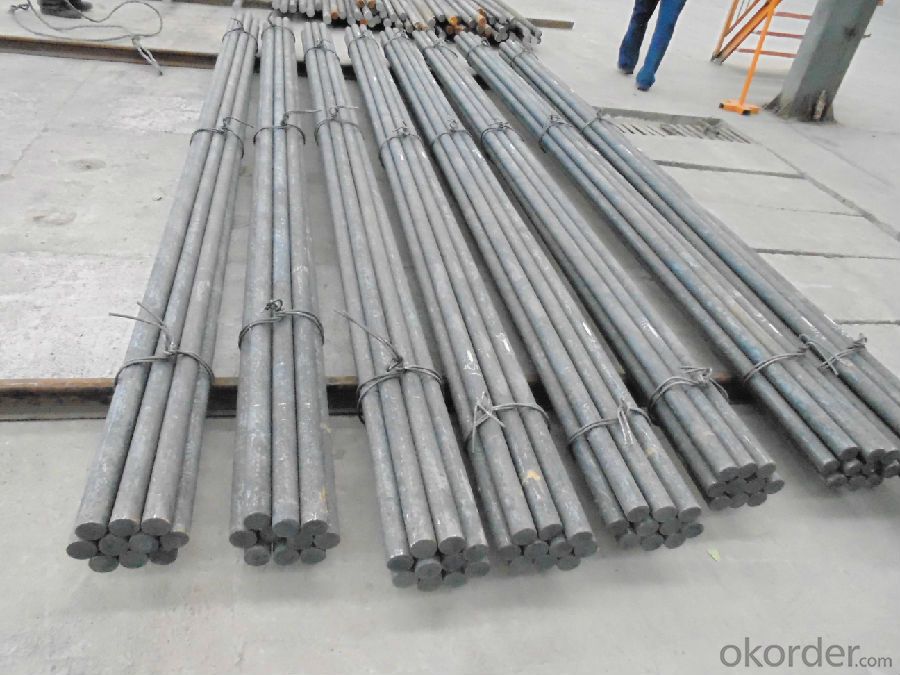
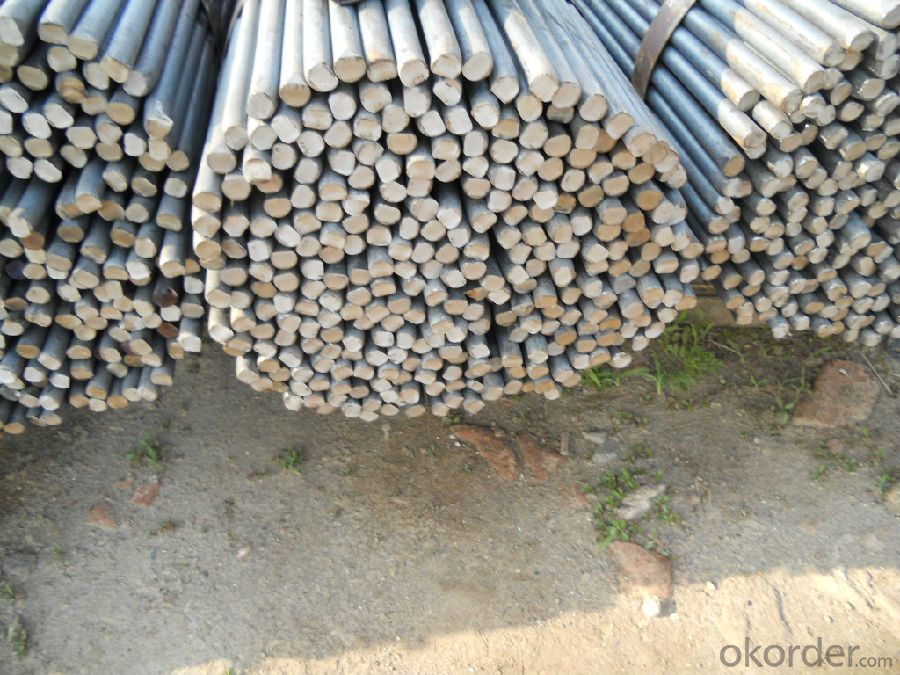
- Q:Can steel round bars be used in structural applications?
- Yes, steel round bars can be used in structural applications. They are commonly used in construction projects for their strength and durability. Steel round bars provide structural support and reinforcement in various applications such as beams, columns, and braces.
- Q:How do you determine the strength of a steel round bar?
- Various methods can be used to determine the strength of a steel round bar, including physical testing and material specifications. One commonly used method involves conducting a tensile test, where the bar is pulled until it breaks. This test helps determine the ultimate tensile strength (UTS) of the steel, which is the maximum stress it can handle before fracturing. The UTS is typically measured in units of force per cross-sectional area, such as pounds per square inch (psi) or megapascals (MPa). Another important strength property to consider is the yield strength. This is the stress level at which the steel starts to permanently deform, without any increase in load. The yield strength is crucial in assessing the structural integrity of the bar, as it indicates the maximum load it can bear without undergoing plastic deformation. In addition to physical testing, the strength of a steel round bar can also be determined by examining its material specifications. Steel manufacturers provide information about the composition and mechanical properties of their products. This includes details about the steel grade, which indicates the alloying elements present in the steel and their concentrations. Different steel grades have varying strength properties, which can help assess the strength of the round bar. It is important to consider that factors like heat treatment or surface conditions can also influence the strength of a steel round bar. Heat treatment processes, such as quenching and tempering, can enhance the strength and hardness of the steel. Additionally, surface conditions like coatings or treatments can improve corrosion resistance. To accurately determine the strength of a steel round bar, it is recommended to consult the material specifications provided by the manufacturer and, if necessary, conduct physical tests like tensile testing.
- Q:What are the advantages of using nickel-manganese alloy steel round bars?
- There are several advantages of using nickel-manganese alloy steel round bars. Firstly, these bars have excellent strength and toughness, making them suitable for applications that require high load-bearing capacity. Secondly, nickel-manganese alloy steel round bars exhibit good corrosion resistance, making them ideal for use in environments with high moisture or chemicals. Additionally, these bars offer good weldability, allowing for easy fabrication and assembly. Lastly, the inclusion of nickel and manganese in the alloy enhances the bars' heat resistance, making them suitable for applications involving high temperatures. Overall, the use of nickel-manganese alloy steel round bars provides a combination of strength, corrosion resistance, weldability, and heat resistance, making them a versatile choice for various industrial applications.
- Q:What are the different shapes available in steel round bars?
- Steel round bars are available in a variety of shapes, each designed to meet specific needs and applications. Some of the common shapes of steel round bars include: 1. Round: This is the most common and basic shape of steel round bars. It has a circular cross-section and is widely used in various industries for applications such as construction, manufacturing, and engineering. 2. Square: Square steel round bars have a square cross-section, making them suitable for applications that require stability and structural strength. They are commonly used in the construction of frames, supports, and braces. 3. Hexagonal: Hexagonal steel round bars have six flat sides and are often used in applications that require better grip and torque resistance, such as in machinery and tools. The hexagonal shape allows for a more secure connection and prevents slippage. 4. Flat: Flat steel round bars have a rectangular cross-section with two flat sides. They are commonly used for structural applications, such as in building frames and supports, as well as in the manufacturing of machinery and equipment. 5. Half-round: Half-round steel round bars have a semi-circular cross-section with one flat side. They are often used as decorative elements in architecture and furniture, as well as in the construction of railings and handles. 6. Oval: Oval steel round bars have an elongated oval shape, providing a unique aesthetic appeal. They are commonly used in decorative applications, such as in the design of furniture, railings, and artistic structures. Overall, the availability of different shapes in steel round bars allows for versatility in various industries, enabling engineers, manufacturers, and designers to choose the most suitable shape based on their specific requirements.
- Q:What are the different types of steel round bar surface treatments used in the aerospace industry?
- In the aerospace industry, there are several types of steel round bar surface treatments that are commonly used to enhance the performance and durability of the materials. These treatments are specifically designed to meet the stringent requirements and standards set by the industry. Some of the different types of steel round bar surface treatments used in the aerospace industry include: 1. Passivation: This treatment involves the removal of iron particles and other contaminants from the surface of the steel round bar. It helps to prevent corrosion and improves the overall corrosion resistance properties of the material. 2. Shot Peening: Shot peening is a process that involves bombarding the surface of the steel round bar with small metallic shots. This treatment induces compressive stress on the surface, which enhances the material's fatigue strength and resistance to stress corrosion cracking. 3. Electroplating: Electroplating is a common surface treatment used in the aerospace industry. It involves the deposition of a layer of metallic coating onto the steel round bar through an electrochemical process. This treatment enhances the material's corrosion resistance, wear resistance, and aesthetic appearance. 4. Anodizing: Anodizing is an electrolytic passivation process that is commonly used on aluminum alloys. However, it can also be used on steel round bars. This treatment forms a thick, durable, and corrosion-resistant layer of oxide on the surface, which improves the material's resistance to wear, corrosion, and scratching. 5. Nitriding: Nitriding is a surface hardening treatment that involves the diffusion of nitrogen into the surface of the steel round bar. This treatment improves the material's surface hardness, wear resistance, and fatigue strength. 6. Chemical Conversion Coating: Chemical conversion coating is a treatment that involves the formation of a thin, protective layer on the surface of the steel round bar. This coating enhances the material's corrosion resistance and provides a good base for subsequent paint or coating applications. These are just a few examples of the different types of steel round bar surface treatments used in the aerospace industry. Each treatment offers unique benefits and is selected based on the specific requirements of the application, such as corrosion resistance, wear resistance, fatigue strength, and aesthetic appearance.
- Q:What are the advantages of using creep-resistant steel round bars?
- Using creep-resistant steel round bars in various applications has several advantages. Firstly, these bars offer exceptional resistance to high temperatures and prolonged stress exposure, making them ideal for high temperature environments such as power plants, boilers, and engines. Their ability to maintain their mechanical properties at elevated temperatures is a key advantage. Secondly, these round bars possess superior creep strength, allowing them to endure constant stress over extended periods without deformation or failure. This is particularly crucial in applications where components are subjected to continuous stress, such as pressure vessels or structural machinery. The high creep strength ensures the longevity and reliability of these components. Additionally, creep-resistant steel round bars exhibit excellent corrosion resistance. They are often alloyed with elements like chromium, molybdenum, or nickel, enhancing their ability to resist corrosion in harsh environments. This makes them suitable for industries like oil and gas, chemical processing, and marine applications where corrosion is a significant concern. Furthermore, these round bars possess favorable weldability, facilitating easy fabrication and assembly. They can be welded to other components without compromising their mechanical properties, making them versatile and cost-effective for construction projects. Moreover, these round bars offer dimensional stability and high hardness, guaranteeing that components maintain their shape and mechanical properties even under extreme conditions. This characteristic makes them suitable for applications requiring precision and accuracy, such as aerospace and automotive industries. In conclusion, the advantages of using creep-resistant steel round bars include their ability to withstand high temperatures, superior creep strength, corrosion resistance, weldability, dimensional stability, and high hardness. These advantages make them the preferred choice for various industries where reliability, longevity, and performance under harsh conditions are essential considerations.
- Q:What's the difference between Q345 round steel and No. 45 round steel material?
- Q345 round steel is different from round steel No. 45:Q345 round steel containing Mn, but containing C below 45# round bar45# round steel containing C is higher than Q345 round steel, but without Mn
- Q:Can steel round bars be used in the manufacturing of firearms?
- Yes, steel round bars can be used in the manufacturing of firearms. Steel is a commonly used material for firearm construction due to its strength, durability, and ability to withstand high pressures and temperatures. Round bars made of steel can be machined, forged, or cold drawn to create various firearm components such as barrels, receivers, and bolts.
- Q:Are steel round bars suitable for welding?
- Yes, steel round bars are suitable for welding. Steel round bars are commonly used in welding applications due to their excellent strength and durability. They can be easily welded using various welding techniques such as MIG (Metal Inert Gas), TIG (Tungsten Inert Gas), or stick welding. However, it is important to choose the appropriate welding method and consumables based on the specific grade and alloy composition of the steel round bar to ensure a successful weld. Additionally, proper surface preparation and cleaning are crucial to achieve strong and reliable welds. Overall, steel round bars are a popular choice for welding projects due to their versatility and ability to withstand high temperatures and stress.
- Q:How are steel round bars used in the automotive industry?
- Due to their strength, durability, and versatility, steel round bars are commonly employed in the automotive industry for a range of purposes. The production of crankshafts is one of the primary uses of steel round bars in this industry. Crankshafts are essential in converting the reciprocating motion of pistons into rotational motion, which powers the vehicle. Steel round bars are highly suitable for this function due to their high tensile strength, exceptional fatigue resistance, and ability to endure high torque loads. Steel round bars are also utilized in the manufacture of axles. Axles play a critical role in transferring power from the engine to the wheels while supporting the vehicle's weight and ensuring stability. Steel round bars provide the necessary strength and rigidity to handle the substantial loads and forces experienced by axles. Furthermore, steel round bars are employed in the production of suspension components like tie rods and sway bars. Tie rods are crucial for steering and maintaining proper alignment, while sway bars help control body roll and enhance handling. Steel round bars are preferred for these applications due to their exceptional torsional strength, enabling them to withstand the forces and stresses encountered during steering and suspension movements. Moreover, steel round bars are used in the creation of transmission shafts. Transmission shafts are responsible for transmitting power from the engine to the wheels through the gearbox. Steel round bars are well-suited for this task due to their high strength, resistance to bending, and ability to handle the rotational forces and torque generated by the engine. In conclusion, steel round bars are extensively employed in the automotive industry for various applications including crankshafts, axles, suspension components, and transmission shafts. Their superior strength, durability, and versatility make them an ideal choice for these critical components, ensuring the safety, performance, and reliability of vehicles.
1. Manufacturer Overview |
|
|---|---|
| Location | |
| Year Established | |
| Annual Output Value | |
| Main Markets | |
| Company Certifications | |
2. Manufacturer Certificates |
|
|---|---|
| a) Certification Name | |
| Range | |
| Reference | |
| Validity Period | |
3. Manufacturer Capability |
|
|---|---|
| a)Trade Capacity | |
| Nearest Port | |
| Export Percentage | |
| No.of Employees in Trade Department | |
| Language Spoken: | |
| b)Factory Information | |
| Factory Size: | |
| No. of Production Lines | |
| Contract Manufacturing | |
| Product Price Range | |
Send your message to us
Hot Rolled Prime Low Carbon Steel Round Bar
- Loading Port:
- China main port
- Payment Terms:
- TT OR LC
- Min Order Qty:
- 100 m.t.
- Supply Capability:
- 5000 m.t./month
OKorder Service Pledge
OKorder Financial Service
Similar products
New products
Hot products
Hot Searches
Related keywords

